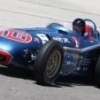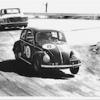I have never seen figures for weights of Grand Prix cars that I regard as 100% reliable, but for what it's worth, here is a selection:
Pomeroy, The Grand Prix Car vol 2, laden weight quoted in cwt:
1947 Alfa Romeo 19.5cwt (2,184lbs)
1950 Alfa Romeo 20.5cwt (2,296lbs)
1951 Alfa Romeo 21.5cwt (2,408lbs)
1949 Ferrari 17cwt (1,904lbs)
1951 Ferrari 20.5cwt (2,296lbs)
1952 Ferrari 16cwt 1,792lbs)
1953 BRM 20cwt (2,240lbs)
1953 Maserati 16cwt (1,792lbs)
Setright, The Grand Prix Car Vol3, unladen and starting line weight, quoted in lbs
W196 unladed weight 1,430lbs (medium wheelbase, 1,540lbs (streamlined), starting line weight (he doesn't say which variant!) 2,000lbs
Maserati 250F (1954) unladen 1,300lbs, starting line 1,850lbs
Maserati 250F (1957) unladen 1,290lbs, starting line 1,800lbs
Ferrari 555 Unladen 1,400lbs, starting line 1,900lbs
Vanwall (1958) unladen 1,400lbs, Starting line 1,800lbs
Ferrari Dino 246 (1958) unladen 1,220lbs, starting line 1,680lbs
BRM 25 (1959) unladen 1,520lbs, starting line 1,900lbs)
Cooper (1959) unladen 1,150lbs, starting line 1,500lbs
Lotus 18 (1960) unladen 980lbs, starting line 1,325lbs
Robert Jarraud (Les Gordinis) quotes the following (all in kg, "Poids de la Voiture a Vide" which I think is similar to British unladen weight)
Type 15 428kg (941lbs)
Type 15C 465kg (1,023lbs)
Type 20 644kg (1,416lbs)
Type 32 721kg (1,586lbs)
Ian H Smith (Lotus, The Story of the Marque), quotes an estimated dry weight 0f 620lbs for the 12.
Caveat emptor.
Edited by Roger Clark, 07 December 2014 - 15:56.

















